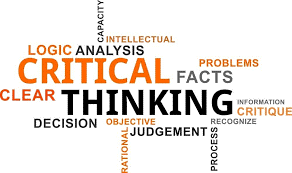Why does it matter?
 Professionals want to follow occupations in which they are interested. While finding joy and significance in one’s work is beneficial to productivity, it’s also necessary to make sure that strong emotions and impulses don’t obscure critical thinking at work. To avoid costly mistakes, professionals should apply critical thinking to all parts of their work. All organizational departments, from recruiting to marketing and sales, should stress critical thinking in workplace decisions. Jen Lawrence, co-author of Engage the Fox: A Business Fable About Thinking Critically and Motivating Your Team, defines critical thinking as “the ability to solve problems effectively by systematically gathering information about an issue, generating further ideas involving a variety of perspectives, evaluating the information using logic, and making sure everyone involved in on board.” This is a difficult definition for a difficult concept. Though it may appear simple to take a step back and use a formal thought process rather than reacting immediately to conflicts or difficulties, it is far more difficult to do. Workplace critical thinking abilities can and should be taught so that they become second nature.
Professionals want to follow occupations in which they are interested. While finding joy and significance in one’s work is beneficial to productivity, it’s also necessary to make sure that strong emotions and impulses don’t obscure critical thinking at work. To avoid costly mistakes, professionals should apply critical thinking to all parts of their work. All organizational departments, from recruiting to marketing and sales, should stress critical thinking in workplace decisions. Jen Lawrence, co-author of Engage the Fox: A Business Fable About Thinking Critically and Motivating Your Team, defines critical thinking as “the ability to solve problems effectively by systematically gathering information about an issue, generating further ideas involving a variety of perspectives, evaluating the information using logic, and making sure everyone involved in on board.” This is a difficult definition for a difficult concept. Though it may appear simple to take a step back and use a formal thought process rather than reacting immediately to conflicts or difficulties, it is far more difficult to do. Workplace critical thinking abilities can and should be taught so that they become second nature.
Critical thinking is vital because it guarantees that you have the best solution to an issue, with maximum buy-in from all stakeholders – an outcome that will save your company time, money, and stress in the long run. Here’s how you grasp critical thinking, embrace it, and put it into practice at work.
How to Recognize Good Critical Thinking
Critical thinking skills can be taught in the workplace so that people can use them before, not after, a crisis occurs.
 Lawrence used the example of restaurants and wait staff: If a customer has a terrible experience at a restaurant, a waiter who uses critical thinking abilities is more likely to come up with a way to salvage the situation, such as offering a complimentary appetizer or a discount. “This has the potential to save the hard-won customer connection you spent a lot of money on.” This idea can be used to a variety of commercial and organizational systems. While the restaurant example illustrates critical thinking abilities, you should be mindful of the indicators indicating a lack of these abilities. According to Lawrence, companies that change strategy frequently, jumping from one thing to the next, are unlikely to engage in critical thinking. This is also true with businesses that appear to have solid ideas but struggle to put them into action.
Lawrence used the example of restaurants and wait staff: If a customer has a terrible experience at a restaurant, a waiter who uses critical thinking abilities is more likely to come up with a way to salvage the situation, such as offering a complimentary appetizer or a discount. “This has the potential to save the hard-won customer connection you spent a lot of money on.” This idea can be used to a variety of commercial and organizational systems. While the restaurant example illustrates critical thinking abilities, you should be mindful of the indicators indicating a lack of these abilities. According to Lawrence, companies that change strategy frequently, jumping from one thing to the next, are unlikely to engage in critical thinking. This is also true with businesses that appear to have solid ideas but struggle to put them into action.
What happens at the top, like with many issues in business, is a good indicator of how present critical thinking is in the rest of the firm. There will be no buy-in if a company has a brilliant leader with great ideas but no processes in place, and the company will suffer. “Critical thinking not only helps you arrive at the best answer, but also at a solution that most people accept,” Lawrence explained. No matter what type or size of company you have, modelling critical thinking from the top will assist the skill trickle down to the rest of the organization.
Critical thinking is actively adopted in a company when mistakes are avoided and business runs smoothly at all levels, not only at the leadership level. Critical thinking may become a second-nature talent for employees of all levels of experience and seniority with the right training, time, and patience. The money, time, and conflict you’ll save in the long run will be well worth the extra effort and patience it will take to incorporate critical thinking in your business.

 Español
Español Deutsch
Deutsch Polski
Polski Português
Português Română
Română